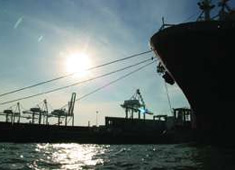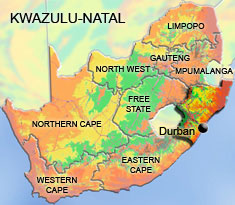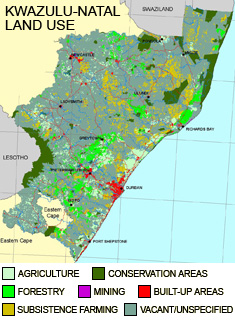Investing in KwaZulu-Natal
Kwazulu-Natal is an important hub of industrial development in sub-Saharan Africa,
thanks to its rich natural resources and well-developed infrastructure.
Economic activities in the province are mainly concentrated on the port of Durban and
the capital, Pietermaritzburg, with significant contributions in the Richards Bay-
Empangeni area, the Ladysmith-Ezakheni area, the Newcastle-Madadeni regions as
well as on the south coast.
Investment opportunities
KwaZulu-Natal is a competitive region for foreign investment, particularly for re-
export opportunities through the port of Durban.
The province has identified nine prime
targets for inward investment: textiles,
clothing, plastic products, chemicals, fabricated metal products, automotive
components, wood and wood products, footwear, machinery and appliances. Of these,
primary and processed aluminium at world competitive prices from local suppliers,
provides a real opportunity for investors in the sector.
 Trade and
Investment KwaZulu-Natal
Trade and
Investment KwaZulu-Natal
Trade and Investment KwaZulu-Natal promotes strategic business growth in the
province. Services to prospective inward investors include:
- Pre- and post-establishment support, such as feasibility studies, liaison with
government departments, marketing, technical and financial analyses, and assistance
with legal formalities and regional regulations.
- Provision of infrastructure and utilities.
- Lease or sale of land and property.
- Loans for acquisition of plant and equipment.
- Working capital loans.
- Introductions to key contacts, such as auditing companies, legal practitioners,
material suppliers and shipping groups.
Industry
Richards Bay is the centre of operations for South Africa's aluminium industry. The
Richards Bay Coal Terminal is instrumental in securing the country's position as the
second-largest exporter of steam coal in the world. Richards Bay Minerals is the
largest sand-mining and mineral-processing operation in the world.
The vehicle-manufacturing industry has created a considerable multiplier effect in
component and service providers. The automotive leather industry has grown rapidly,
with exports
significantly increasing foreign exchange earnings. KwaZulu-Natal has
also recently undergone rapid industrialisation, thanks to its abundant water supply
and labour resources. Industries are found at Newcastle, Ladysmith, Dundee, Richards
Bay, Durban, Hammarsdale, Richmond, Pietermaritzburg and Mandeni.
Substantial progress has been made to the Dube Trade Port and King Shaka
International Airport project at La Mercy. It is estimated that redevelopment of the
current airport site will create 269 200 jobs over a 25-year period. The airport is
expected to be operational by 2010, in time for the Fifa Football World Cup.
Manufacturing
The three largest manufacturing
industries are pulp and paper products (19%),
chemicals and petrochemicals (17%), and food and beverages (16%.)
In the chemicals and petrochemicals sector, industrial chemicals comprise a third, at
R1.1-billion, of the gross output, petroleum and coal products 30% at R1-billion,
chemicals 21% at R700-million, and rubber and plastic products the balance.
In the textiles, clothing and leather sector, which represents 15% of the
manufacturing sector, textiles contributed 54% at R1.6-billion and clothing 27% at
R800-million.
The manufacturing sector is geared for export, with nearly a third of South Africa's
manufactured exports being produced in KwaZulu-Natal.
Tourism
The Lubombo Spatial Development Initiative (see below) has created unique
opportunities for investment in tourism in the St Lucia region. The governments of
Mozambique, South Africa and Swaziland are launching tourism investment
opportunities on a scale unparalleled in
Africa - in an area of immense potential
underpinned by a wealth of natural and cultural resources, including a pristine
coastline, classic African game parks, the southernmost coral reefs in Africa and rich
indigenous cultures.
Lubombo Spatial Development Initiative
Straddling southern Mozambique, eastern Swaziland and northern KwaZulu-Natal, the
Lubombo region has some of the most picturesque and unspoiled natural attractions in
Africa. At the heart of the region nestles the Greater St Lucia Wetland Park, one of
South Africa's seven Unesco World Heritage Sites.
The Lubombo region is currently enjoying the biggest and most prolonged tourism
boom in its history. The year 2005 marked the 17th successive year of increased
foreign visitor arrivals in South Africa,
with a record of over 7-million overseas
tourists choosing to holiday in the country.
The growth in international tourism comes on top of a large, established domestic
tourism market currently worth twice as much as its foreign counterpart.
Recognising the opportunities offered by this robust growth, a number of excellent
tourism investment opportunities have been identified in each of the three countries.
These range from beach resorts to boutique hotels and game lodges, and are designed
to help establish the Lubombo region as global tourism destination.
Until now, the region's inaccessibility has inhibited development beyond some game
reserves and a few lodges. A major new tourist road and secondary roads are being
constructed as part of the Lubombo SDI.
Some R630-million has been committed to regional support networks such as new
roads and the upgrading of the major national access route, park infrastructure such
as game fences, internal road networks
and tourism facilities, the restocking of the
park and various regional programmes that include major new malaria eradication
drive.
Download the Department of Trade and Industry's
Provincial Economic
Overview (1.8 MB)
here.
SAinfo reporter
 Trade and
Investment KwaZulu-Natal
Trade and Investment KwaZulu-Natal promotes strategic business growth in the
province. Services to prospective inward investors include:
Trade and
Investment KwaZulu-Natal
Trade and Investment KwaZulu-Natal promotes strategic business growth in the
province. Services to prospective inward investors include:
 Durban harbour in KwaZulu Natal is the busiest port in South Africa (Image: Trade and Investment KZN)
Durban harbour in KwaZulu Natal is the busiest port in South Africa (Image: Trade and Investment KZN)
 KwaZulu-Natal takes up 7.6% of South Africa's total land area (Image: Mary Alexander)
KwaZulu-Natal takes up 7.6% of South Africa's total land area (Image: Mary Alexander)
 Map: Department of Environment and Tourism
Map: Department of Environment and Tourism










